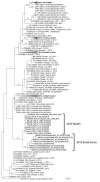Variations in Spike Glycoprotein Gene of MERS-CoV, South Korea, 2015
- PMID: 26691200
- PMCID: PMC4696701
- DOI: 10.3201/eid2201.151055
Variations in Spike Glycoprotein Gene of MERS-CoV, South Korea, 2015
Abstract
An outbreak of nosocomial infections with Middle East respiratory syndrome coronavirus occurred in South Korea in May 2015. Spike glycoprotein genes of virus strains from South Korea were closely related to those of strains from Riyadh, Saudi Arabia. However, virus strains from South Korea showed strain-specific variations.
Keywords: MERS-CoV; Middle East respiratory syndrome; Middle East respiratory syndrome coronavirus; South Korea; genetic evolution; outbreak; recombination; spike glycoprotein gene; viruses.
Figures


References
-
- Zaki AM, van Boheemen S, Bestebroer TM, Osterhaus AD, Fouchier RA. Isolation of a novel coronavirus from a man with pneumonia in Saudi Arabia. N Engl J Med. 2012;367:1814–20 and. - PubMed
-
- World Health Organization WHO). Laboratory testing for Middle East respiratory syndrome coronavirus. Interim guidance (revised). WHO/MERS/LAB/15.1. Geneva: The Organization; 2015. [cited 2015 Oct 15]. http://apps.who.int/iris/bitstream/10665/176982/1/WHO_MERS_LAB_15.1_eng.pdf
Publication types
MeSH terms
Substances
LinkOut - more resources
Full Text Sources
Other Literature Sources

